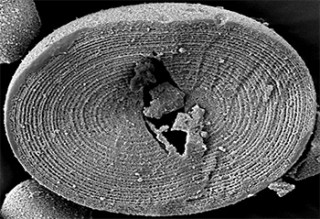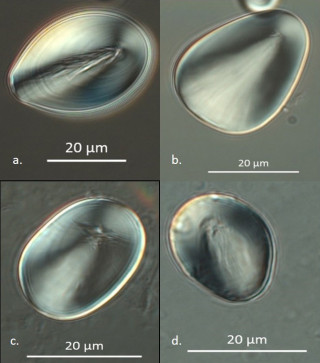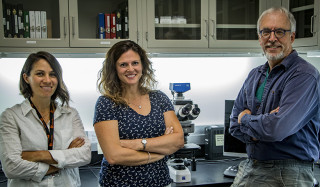In the Tiny World of Starch Grains, Bigger is Better
By Michael Mozdy
Starch grains are tiny structures made by most plants as products of photosynthesis. Essentially, a starch grain is a well-packed storehouse of glucose sugar units. Many plants store starch grains in underground organs such as roots, bulbs, tubers, and rhizomes, as well as their seeds and stems. Starch is the most abundant energy source in our diets today when consumed as potatoes, wheat, corn, and rice. In prehistory, this was also true. (Read Good News About Carbs for a more thorough look at archaeobotanists and their study of ancient diets).
Starch grains are important to archaeologists because they are remarkably stable and resilient over long periods of time. They stay preserved on ancient artifacts and in the archaeological record when other biological structures may not (pollen, seeds, fruit, etc.).
Lisbeth Louderback, our NHMU Curator of Archaeology and U of U assistant professor of Anthropology, published a paper in June 2016 after conducting extensive work on starch grains with her colleagues, Nicole Herzog and Bruce Pavlik. They examined four starchy plants with underground storage organs found in the diets of prehistoric people in the American West: the Four Corners potato, yellow avalanche lily, sego lily, and yellow fritillary. In the paper, they describe why it takes a large sample size of archaeological starch grains to a) make a confident taxonomic identification of the plant, and b) identify unique features of the grain.
To understand their findings, we must dive into the world of starch biology.
Really Small
“You know when you slice a potato, your knife has sticky white residue on it? Those are billions of starch grains,” explains Louderback. While we can see that white smear (and feel the sticky texture), the actual grains are very small. In fact, they’re microscopic: around just 20 microns (µm) in length (a micron, or micrometer, is one millionth of a meter – compare to a millimeter, which is one thousandth of a meter). To put this in perspective, a red blood cell is 9 microns across, a liver cell is 20 microns, and a skin cell is even bigger at 30 microns.
Major Features
Given the right microscopy, these little guys look somewhere between a guitar pick and a flying saucer. Louderback uses several types of microscopy techniques. Under a scanning electron microscope, they have a matte finish and the overall effect is of a lunar landscape. However, when a transmitted light microscope is used, several more features on the starch grains are visible.

Left: Starch grain seen with a scanning electron microscope. Right: one seen with a transmitting light microscope. Photos: Lisbeth Louderback
All starch grains have a hilum, which is the point around which layers of protein are deposited. In tubers, bulbs, and rhizomes, the hilum is often off-center, with growth rings emanating outward from the hilum. Because of this off-center hilum, they can exhibit the “guitar pick” shape.
|

|
“In fact, calling them a guitar pick is a bit off the mark,” corrects Louderback. “Guitar picks are flat and two dimensional while starch grains are spherical or elliptical and three dimensional, more like a tear drop.” Other starch grains like those from grasses and cereal grains have a centered hilum and can be perfectly circular in shape.
The growth rings reveal how the grains are assembled. The basic unit is a product of photosynthesis, glucose. Glucose is a simple sugar that can be linked together into two types of starch chains, amylose and amylopectin. Amylose is a fairly unbranched and linear chain, but amylopectin can be branched and contain up to a hundred thousand glucose units. Amylopectin chains take the form a double helix (not to be confused with the most famous double helix, DNA). Lamellae (essentially layers) of amylose and amylopectin are packed together in each ring, whose complex, three-dimensional structure is still not completely understood. The rings are so densely packed and in such a regular fashion that the grain is almost a crystalline structure. Going on a trip sometime soon? Think of starch as nature’s best packer.
The density of starch leads to one of the more interesting co-evolutionary stories: in order for humans to really achieve nutritional benefit from starch, we need to apply heat and unravel this concentrated kernel of wound-up glucose. So, not until the discovery of fire for cooking would humans be able to truly benefit from carbohydrates.
Back to starch grain features: one of the main identifying characteristics of a starch grain is the presence of birefringent structures. Birefringence is the property of some materials to split light by polarization into two different rays. A Danish scientist first noticed it in a calcite crystal back in 1669. Weirdly, when you turn on a polarized light filter in the transmitting light microscope, starch grains have a telltale set of “arms” and “legs” that come together at the hilum. It’s called the extinction cross, and it has an “X marks the spot” look when the hilum is centered, but to my eye it bears an uncanny resemblance to a chromosome in some starch grains with off-center hila (although they’re completely unrelated).

Left: Birefringence in a calcite crystal, photo: APN MJM / wikipedia. Center: Birefringence in starch grains (extinction cross), photo: Lisbeth Louderback. Right: human chromosomes, photo: Russell Kenny / flickr
One last feature important to Louderback’s study is called the longitudinal fissure. The fissure can be thought of as a triangular trough emanating outward from the hilum. It is not known what function the fissure serves, nor why it is only present in some starch grains and not others.
Louderback’s Findings
“Longitudinal fissures are becoming a defining characteristics of some species,” claims Louderback. It turns out that the longitudinal fissure is quite distinct in each plant species in her study. They can be narrow or wide, branched or unbranched. The picture below shows the four plants in her study and how they have very different longitudinal fissures.

The four starch grains studied in Louderback's paper, each showing a distinct longitudinal fissure. Photos: Lisbeth Louderback
While the longitudinal fissure is a helpful identification feature, it’s not always present. In fact, only 18% of the starch grains in the study had a fissure. Louderback and her colleagues noticed that it was much more prevalent in larger grains, however, and when only large grains are studied, it occurs 50-60% of the time. Larger grains also had more easily identifiable growth rings and shapes.
The authors’ important discovery here is that archaeologists need large sample sizes of their reference and archaeological material in order to make an accurate identification of the species in question. Earlier starch grain studies relied on shape and size of only a few grains to make an identification, but as this paper shows, each species has a wide range of grain sizes, and some variation in shape as well. If archaeologists have a large sample of starch grains, they can focus on the bigger ones, which tend to help them identify what species are present in the sample.

The authors of the study (from left to right): Nicole Herzog, Lisbeth Louderback, and Bruce Pavlik. © NHMU.
Louderback is excited to use this to make more accurate identifications of starch grains on artifacts from other archaeological sites. She is currently working on a paper exploring one of the plants in her study and how humans used it, and we look forward to reading it.
Louderback’s research was accomplished thanks to a generous grant from the National Science Foundation and University of Utah’s Vice President for Research Funding Incentive Seed Grant. Paper under discussion: Louderback, L.A., Herzog, N.M., Pavlik, B.M., 2016. A new approach for identifying starch granules from wild food plants in arid western North America. Starch - Stärke 68, 1–7.
Michael Mozdy is a Digital Science Writer for The Natural History Museum of Utah, a part of the University of Utah in Salt Lake City. Our mission is to illuminate the natural world and the place of humans within it. In addition to housing outstanding exhibits for the public, NHMU is a research museum. Learn more.

